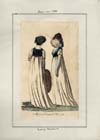
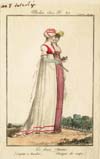
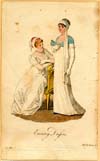


This extant example, offered by Kerry Taylor Auctions, is a silk over-bodice. Additional views here, and here. Note that it is displayed on a modern mannequin, so the front is lower and the back higher than it would be on a corseted figure.

Opera Dress
"A round robe of imperial violet net-crape, or leno, with a long sleeve of the same, worn over a white satin under-dress. A cottage vest, or bodice, of Chinese crape, tabinet, or satin, laced and tagged with correspondent cord and tassels. Under-dress shading closely the bosom and shoulders."
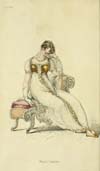
Ball Dress
"A round Grecian robe of white crape, gossamer net, or leno, embroidered up the front, and round the bottom, with a fancy border in marigold chenille; an antique bodice of marigold velvet, trimmed with vandyke lace or white bugle trimming; short full sleeves, same as the robe, finished with bands of marigold velvet."
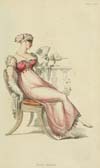
Ball Dress
"A round Circassian robe of pink crape, or gossamer net, over a white satin slip, fringed full at the feet; a peasant's bodice of pink satin or velvet, laced in the fron with silver, and decorated with the same ornament. Spanish slash sleeve, embellished with white crape foldings, and finished at its terminations with bands of silver."
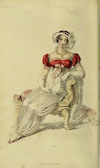
Evening Dress
"A white crape or mull muslin petticoat, worn over white satin, finished round the bottom with a ball fringe of gold; a crimson velvet or satin bodice, formed so as partially to expose the bowom and shoulders; a short bishop's sleeve, edged with ball fringe, and ornamented with the same round the bosom and shoulders. A short sash of shaded riband, to correspond with the colour of the bodice, tied in short bows and ends in front of the figure."
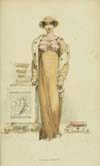
Opera Dress
A round superfine cloth (wool) robe, of the new Russian flame-colour, or pale tan, with long full sleeve, ornamented at the feet with satin of the same colour, in deep vandyke. A fancy bodice, composed of pink satin, and trimming corresponding with the dress, finished with bows of riband on the shoulder. A cap á la Mary of Scotland, composed of the same material as the robe, lined with pink satin, and covered with net beading..."
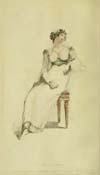
The Vittoria or Wellington Costume, for Evening Dress
"Is composed of Venetian crape, placed over white satin under-dress; a treble row of shell-scallopped lace ornaments the feet, above which is seen a border of variegated laurel. A bodice and Circassian top sleeve of pomona green satin; the bosom interspersed with shell-scalloped lace, and correspondently ornamented. Should, back, and bosom much exposed." (NB: Named for the battle that saw the defeat of the French army under Joseph Bonaparte and Jean-Baptiste Jourdan by Wellington near Vitoria, Spain on June 21, 1813. Decisive victory leading to the defeat of the French in the Peninsular War.)
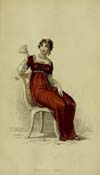
Evening or Opera Dress
"...consists of a round robe of morone or crimson-coloured Merino, kerseymere, or queen's cloth, ornamented round the bottom and up the front with a fancy gold embroidered border. The bodice is composed of satin, or velvet, of the same colour, trimmed round the bosom and sleeves with gold braid and narrow swansdown; the front of the bodice richly ornamented with gold and pearl buttons. A gold band and pearl or diamond clasp confine the bottom of the waist, with a frog pendant on each side, inclining towards the back of the figure. The robe is laced behind with gold cord." (NB: This gown is shown with a matching spencer.)
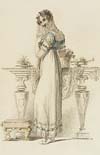
Ball Dress
"A white crape petticoat, worn over gossamer satin, ornamented at the feet with rows of puckered net, with a centre border of blue satin, or velvet, in puffs. A bodice of blue satin, with short full sleeves, and cuffs to correspond with the bottom of the dress. A full puckered border of net, or crape, round the bosom. Stomacher and belt of white satin, with pearl or diamond clasp."

Evening Dress
"A white crape, or fine muslin petticoat, worn over white satin, embroidered in silver lama round the bottom. A bodice of olive, or spring-green satin, ornamented with a silver stomacher. Short, full sleeve, and rounded bosom, trimmed with a full silver border to correspond. A fan frill of fluted lace, continued round the back, and terminating in front at the corner of the bosom. A silver fringe round the bottom of the waist."
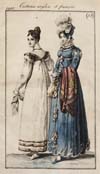
Gown with what appears to be an over-bodice that ties in back.
(NB: Does the pelisse look familiar? See Ackermann, December 1815.)

Figure at left appears to be wearing a white dress with dark overbodice.
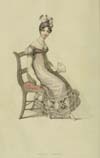
Dinner Dress
"A white British net dress, which is worn over a bright peach-colour satin slip.* The dress is finished at the bottom of the skirt by a row of broad and singularly beautiful trimming, composed of satin to correspond with the slip, which is interspersed with narrow white silk fancy trimming: a row of this latter is placed at the edge of the bottom of the skirt, and another row surmounts the peach and white border. The body is called the corsage á la Circassie; it is composed of peach-colour satin, made without seam, cut very low in the bust, displays exactly the proportions of the shape and is so contrived as to form a novel half-sleeve, which wraps across at the lower part, and displays a full white satin sleeve worn underneath. The body and sleeves are ornamented with narrow white silk trimming, to correspond with the skirt."
* (NB: The watercolorists who colored these fashion plates did not always get the color exact!)
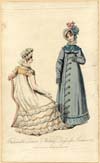
Dinner Dress
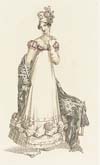
Evening Dress
"A white lace dress over a white satin slip: the bottom of the skirt is trimmed with a drapery of white lace entwined with pearls, and ornamented with full-blown roses without leaves, which are placed at regular distances: a rouleau of white satin is placed above and another below this trimming. Corsage of pale rose-coloured satin, made tight to the shape, and cut so as to display the bust very much: a row of blond lace is set on plain, so as to fall over the corsage. Short full sleeve of rose satin, slashed with white lace, and finished at the bottom by a fall of blond set on plain."
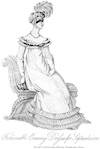
Evening Dress
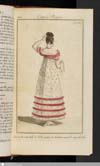
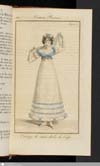
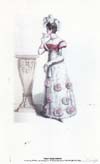
Fancy Ball Dress
(i.e. made to wear at a costume ball)
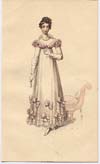
Ball Dress